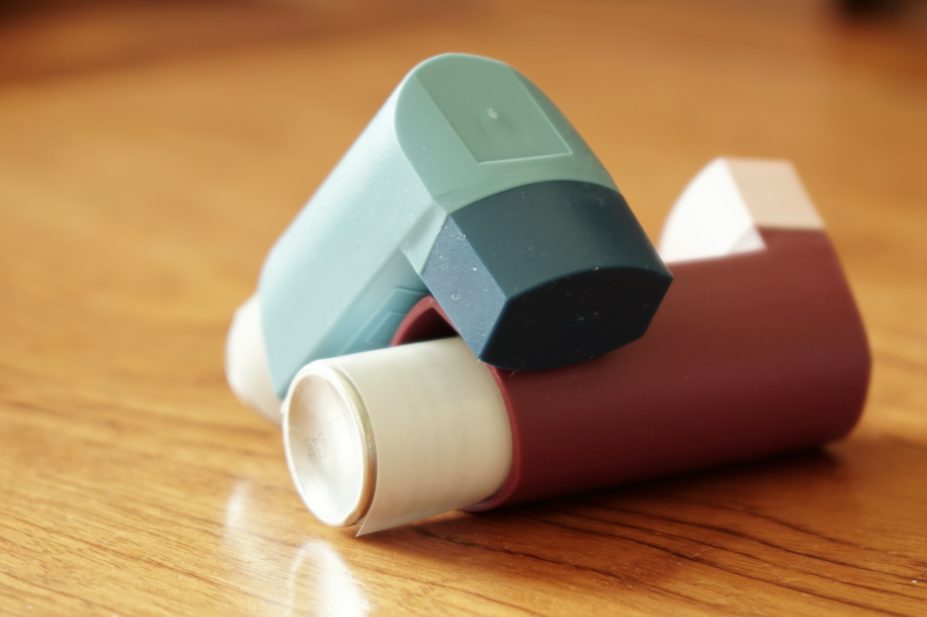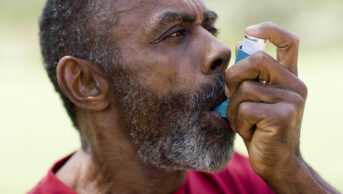
Shutterstock.com
As a pharmacist, when I see people with asthma living their lives to the full — knowing that I have made a meaningful difference — I feel amazing. There is no greater satisfaction in my role than seeing a smiling patient, who feeds back that they know how each of their medicines works, including their preventer inhaler, and that they can optimise the delivery of their medicines through good inhaler technique.
For patients on regular preventer treatment, a short-acting beta-2 bronchodilator (SABA) can be used infrequently when a patient experiences wheeze, chest tightness, breathlessness and cough; and can save lives in an emergency asthma attack situation.
However, more often than not, I see people with asthma who are over-reliant on their reliever — there is evidence that SABA overuse is associated with higher risk of future exacerbation, increased levels of airway inflammation, hospital admission and death[1]
. It is important to note, however, that there is no evidence of harm in the use of SABA in patients with COPD; therefore, SABA should not be stopped in these patients unnecessarily.
The National Institute for Health and Care Excellence suggests that a person who has uncontrolled asthma, and possibly an over-reliance on SABA inhalers, is someone who uses their SABA inhaler for symptomatic relief on three or more days per week[2]
.
The ‘National Review of Asthma Deaths’ (NRAD), published in 2015, reported some alarming findings relating to SABA inhalers: 39% of the people who died of asthma-related causes, who were using a SABA inhaler at the time of death, had been prescribed more than 12 SABA inhalers in the year before they died[3]
. But use of more than 1.5 canisters per year would be excessive for a patient with well-controlled asthma[4]
. Research suggests that overuse of SABA inhalers is a global problem, and it is one we should address[5]
,[6]
,[7]
.
There is also evidence to suggest that there is widespread non-adherence to regular preventer medication (containing inhaled corticosteroids [ICS]) among people with asthma, which increases over time[8]
.
A profound change is needed
Current guidance from the British Thoracic Society and the Scottish Intercollegiate Guidelines Network advises that adults and children with asthma should be prescribed a SABA to relieve their symptoms. For those who have infrequent and short-lived wheeze, they may need their SABA inhaler occasionally, but this may be the only treatment they require. An ICS preventer inhaler should be considered only for those who use SABA three times per week or more; have had an asthma attack in the past two years; are symptomatic three times per week or more; or are waking up one night per week because of their asthma symptoms[8]
.
The message around over-reliance on SABA, and underuse of ICS, does not seem to be getting through
The Primary Care Respiratory Society likens using the reliever inhaler to “damping down a fire”, but it says “to put out the embers and to stop it flaring up you need the [ICS] preventer”[9]
. It would seem that clear instructions on reliever prescriptions and packaging labels are going unheeded, and NRAD reported that 23% of the people included in its report had not received a personal asthma action plan — the message around over-reliance on SABA, and underuse of ICS, is not getting through[3]
.
In the UK, we need to take more drastic measures in asthma care, and the Global Initiative for Asthma’s (GINA) strategy, published in April 2019, provides this radical approach[10]
.
Making inhaled corticosteroids the norm
The GINA recommendations are based on the understanding that airway inflammation is present in even so-called ‘mild’ or newly diagnosed asthma[11]
.
For adults and adolescents with mild asthma who have infrequent asthma symptoms (occurring less than twice per month), GINA recommends treating with as-needed low-dose ICS-formoterol, without the need for regular preventer treatment[10]
.
GINA reports a study showing that this treatment reduces the risk of severe exacerbations by about two-thirds, compared with SABA-only treatment, and is non-inferior to daily low-dose ICS, but inferior in controlling symptoms[12]
. And patients in the ICS-formoterol group had approximately one-quarter of the inhaled glucocorticoid exposure of those in the low-dose ICS maintenance group[12]
.
It is important to note, as-needed low-dose ICS-formoterol is off label — formoterol is a long-acting beta-2 agonist (LABA) that acts rapidly like a SABA. As an alternative, a patient could use their ICS (off label) as well as SABA when it is required; however, there is not currently a SABA/ICS combination inhaler available in the UK. This combination would require two devices, which could affect patient convenience and adherence, and incur an extra prescription charge. These options will require optimal inhaler technique to ensure ICS is received when a fast-acting reliever is needed.
If there is a need to use the as-needed treatment more than twice per month, GINA recommends either regular low-dose ICS with as-needed SABA, or as-needed low-dose ICS-formoterol (off label) more frequently. Other options include leukotriene receptor antagonists (LTRA) — less effective than ICS — or taking ICS whenever SABA is taken (off label)[10]
.
Treatment should be escalated if a patient’s asthma is troublesome most days, or if the patient is waking owing to asthma once per week or more. Options include low-dose ICS/LABA as maintenance and reliever therapy; low-dose ICS/LABA as conventional maintenance treatment with as-needed SABA; or medium-dose ICS with as-needed SABA[10]
.
Adopting the new guidelines could be difficult
Inhaled SABA has been the first-line treatment for asthma for around 50 years; dating to a time when asthma was thought to be a disease of bronchoconstriction, meaning it may be hard to challenge years of practice[13]
.
Many clinicians and patients still believe that regular SABA use is normal; for example, before using ICS to ‘open up’ the airways, or before exercise.
Patients are often satisfied with, and rely on, their SABA treatment — it rapidly relieves symptoms during breathless moments, and makes them feel as though they have control of their asthma, meaning they often do not see the need for additional treatment[14]
.
This normality of SABA overuse is reinforced by its prominence in A&E, hospital management of exacerbations, and its low cost[14]
. As-needed ICS-formoterol could be a more costly alternative[12]
.
The most obvious barrier to adopting the GINA guidelines in the UK is that as-needed ICS-formoterol is not currently licensed, and, if a licence was granted and UK guidelines were updated, it would take time to embed the new practice — as well as a great deal of education for patients and clinicians.
There will be some challenging questions to answer, such as: what will be the first inhaler you give a newly diagnosed patient? At the moment, it tends to be the reliever. How will it feel, for the patient and clinician, to start out with a preventative LABA/ICS? Will we take asthma diagnosis and treatment more seriously as a result?
Ground-breaking yet logical
For safety, GINA no longer recommends SABA alone in the treatment of asthma in adults and adolescents. Its recommendation that all patients should be provided with ICS-formoterol (as-needed in mild asthma) from the start of therapy, is ground-breaking yet logical. The guidance allows consistent messaging about the need for both symptom relief and risk reduction, and this regimen may help to avoid patients becoming reliant on SABA as their main asthma treatment.
The ‘NHS long-term plan’ enshrined its aim to make sure those with respiratory diseases are supported to “receive and use the right medication”, particularly through pharmacist work to “reduce the use of [SABA] inhalers” — the GINA recommendations, therefore, demand consideration in the UK[15]
.
A challenge against repeat prescriptions of SABA in the absence of a corresponding ICS prescription could not be more urgent.
Darush Attar-Zadeh, respiratory lead pharmacist, Barnet Clinical Commissioning Group
Acknowledgements: Christine Heading, pharmacist, North West London; Noel Baxter, GP, Southwark
References
[1] Martin MJ & Harrison TW. Eur Respir J 2019;53(4)1802223. doi: 10.1183/13993003.02223-2018
[2] National Institute for Health and Care Excellence. 2017. Available at: https://www.nice.org.uk/guidance/ng80 (accessed February 2020)
[3] Royal College of Physicians. 2015. Available at: https://www.rcplondon.ac.uk/projects/outputs/why-asthma-still-kills (accessed February 2020)
[4] Attar-Zadeh D. Clin Pharm 2019(2):35–36. doi: 10.1211/CP.2019.20206055
[5] Belhassen M, Nibber A, Van Ganse E et al. NPJ Prim Care Respir Med 2016;26:16076. doi: 10.1038/npjpcrm.2016.76
[6] Gerald JK, Carr TF, Wei CY et al. J Allergy Clin Immunol Pract 2015;3(6):957–962. doi: 10.1016/j.jaip.2015.06.021
[7] Slejko JF, Ghushchyan VH, Sucher B et al. J Allergy Clin Immunol 2014;133(6):1579–1587. doi: 10.1016/j.jaci.2013.10.028
[8] British Thoracic Society and the Scottish Intercollegiate Guidelines Network. 2019. Available at: https://www.brit-thoracic.org.uk/quality-improvement/guidelines/asthma/ (accessed February 2020)
[9] The Primary Care Respiratory Society. 2019. Available at: https://www.pcrs-uk.org/resource/question-and-challenge-practice (accessed February 2020)
[10] Global Initiative for Asthma. 2019. Available at: https://ginasthma.org/wp-content/uploads/2019/06/GINA-2019-main-report-June-2019-wms.pdf (accessed February 2020)
[11] Papi A, Brightling C, Pedersen SE et al. Lancet 2018;391(10122):783–800. doi: 10.1016/S0140-6736(17)33311-1
[12] O’Byrne PM, FitzGerald JM, Bateman ED et al. N Engl J Med 2018;378(20):1865–1876. doi: 10.1056/NEJMoa1715274
[13] Burki TM. New asthma treatment recommendations. Lancet Respir Med 2019;7(6):479. doi: 10.1016/S2213-2600(19)30150-X
[14] Global Initiative for Asthma. 2019. Available at: https://ginasthma.org/wp-content/uploads/2019/04/Whats-new-in-GINA-2019_V2.pptx (accessed February 2020)
[15] NHS. 2019. Available at: https://www.longtermplan.nhs.uk/wp-content/uploads/2019/08/nhs-long-term-plan-version-1.2.pdf (accessed February 2020)


